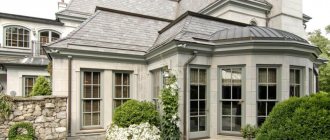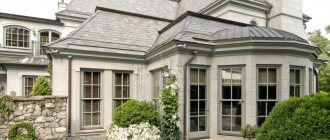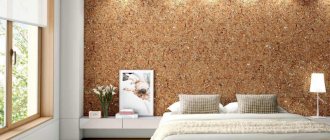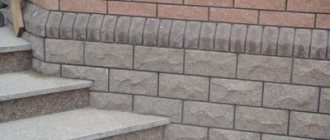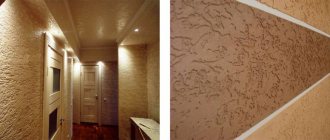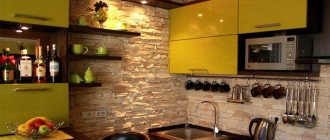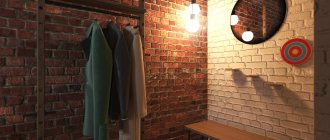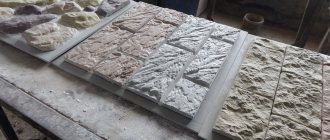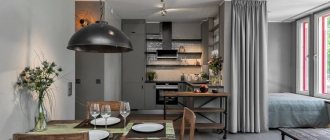Decorating walls with stone is an original way to decorate an apartment. Use it in combination with wallpaper or paint for an original effect. Read our article to learn how to choose a stone for your wall. We will advise which layout styles are best suited for this type of finish.
What will you read about in the article?
- Decorating walls with stone - pros and cons
- Stone walls of the hall - what material to choose?
- Stone on the wall in the living room - what to use?
- Which stone to choose for the wall in the kitchen?
- Is rock on the bathroom wall a good idea?
- Plaster and concrete stone for the wall - is it worth it?
Decorating walls with stone - pros and cons
A stone for the wall will allow you to get an unusual location. Thanks to the material, you can add variety to your decor - all you have to do is apply it to one wall. An entire room covered in stone can have an overwhelming effect, especially in a small interior.
Stone for the wall can be combined with both wallpaper and paintwork. It all depends on what design style you plan to use in the interior. The advantage of decorative stone for walls is that it works well in both dry and wet areas. Don't worry, use it in the bathroom or kitchen - with proper protection, it will be resistant to moisture and dirt.
The stone for the wall will act as sound insulation. This makes it ideal for homes with small children. The material also protects against dirt - it is more resistant than wallpaper or a painted surface. The stone wall is also insensitive to mechanical damage.
A stone on the wall is not a solution without flaws. Price can be an issue for many planning a renovation. Natural raw materials even cost several thousand rubles per m2.
The cost of a stone wall increases the need to hire specialists for assembly. With painting or wallpaper, most people can handle it themselves, but in the case of natural raw materials it is better not to take risks. A stone that is not properly glued to the wall may fall and this is dangerous.
Stone for a wall - is it worth it?
- Natural material diversifies the appearance of the interior,
- Looks good in combination with wallpaper and a wall covered with paint,
- Works great in dry and damp areas,
- Isolates sounds good
- Expensive,
- Installation must be done by a specialist, which further increases costs.
Leaving visible stone in an old home will highlight the rustic look of the interior.
Features of plastering work on the facade
Experts believe that the easiest way to make decorative stone is based on a ready-made mixture, but you can prepare the composition yourself. You can get an imitation of any rock or ornamental gem.
Universal cladding for facades, characterized by high durability and aesthetics. External work is carried out in compliance with the technology indicated on the packaging, adjusted for temperature and humidity. Sometimes you have to moisten the surface so that it does not dry out. Overheating in the sun with rapid polymerization is undesirable; it will complicate decoration.
Universal cladding for facades, characterized by high durability and aesthetics.
How to do it yourself, stages of implementation
To reduce repair costs, it is recommended to master all stages of application. It can be used to cover walls and foundations, steps and columns. After application, the relief is extruded with a polymer stamp, then the seams are formed.
To obtain the highest quality coating, use three layers:
- Starting plaster will eliminate all wall defects and prepare the surface; this layer is not leveled.
- The primer layer is applied no earlier than 2-3 hours later, when the base has hardened.
- The covering layer is the surface on which the stone effect is formed, decorating in the way you like.
After application, the relief is extruded with a polymer stamp, then the seams are formed.
Obviously, it is easier to decorate any vertical or inclined surface with an imitation of wild rock using special plaster. This simplifies the processing of spherical, arched and curved shapes, which is difficult when facing with stone blocks. The finished surface is difficult to distinguish from natural granite or basalt, and plaster is much lighter.
Stone walls in the hall - what material to choose?
The hall is the space that guests see first. The interior is a preview of the style that was used throughout the rest of the house, so it pays to use quality materials. The corridor is especially susceptible to contamination, for example by sand or wet clothes. A stone room can be comfortable and maintain its aesthetic appearance for a long time - all you need to do is choose the right material.
The stone in the hallway should be light in color because this space usually has little access to natural light. A suitable material would be sandstone, which is commonly used as a flooring material. The stone comes in different colors and depends on where it is mined. However, the most popular colors of sandstone are beige and brown, which are ideal as decorative stone for a hallway.
Slate will also work as stone in a hallway. If the hall in your home has access to natural light and is spacious, choose black tiles. It will look great in an interior decorated in Scandinavian and modern style.
A corridor made of stone with slate in the main role will be not only stylish, but also convenient to use. Don't be afraid of black tiles because the raw material has the advantage of not fading. The attractive decorative stone for the hall is also stain and water resistant. Its durability is evidenced by the fact that it is often used as flooring on the veranda.
Using slate in the interior
Stone wall - what material to choose?
- Sandstone is ideal for the hallway, which comes in different colors, but the most popular are beige and brown,
- Slate is also suitable as a stone in the hall; if you have a spacious hallway, choose the black option, which looks modern,
- Slate is resistant to dirt and moisture and does not fade,
- A small hallway without access to natural light will benefit from bright sandstone tiles.
Natural stone on the walls will be ideal in a large hall
Application technology
The essence of the technique of simulating natural materials comes down to three main stages:
- Create an external surface texture - blocks, cobblestones, bricks, solids.
- Give the necessary shape to the relief, which is typical for blocks, cobblestones, bricks, as well as surfaces made up of these elements.
- Use paint close to natural shades.
It is worth highlighting some special techniques. With the “Wild Stone” technology, plaster is applied to a small section of the wall, after which it is covered with a finishing coating and then a trowel is used to give the appearance of a stone surface. Upon completion of drying, veins are made by coloring by rubbing into the surface with a sponge.
The Marmorino technique is performed by knocking out rectangular boundaries with a chisel on completely dry plaster. The “Torn Stone” style is designed in an illogical way, but the notches are made in a chaotic manner.
Preparing the base
In work where you need to create a decorative coating with maximum imitation of natural stone, every stage is important, including preparation. This especially applies to interior decoration. The main thing is to ensure adhesion of the plaster to the base, which will allow you to lay the material in an even layer. Subsequently, dirt stains should not appear through the finish.
The scope of preparatory work comes down to the following:
- The surface is cleaned of all contaminants without exception.
- Uneven walls are leveled using cement-sand mortar or gypsum mixture.
- If there are chips, cracks, or large gouges, the defects are repaired with cement and sand and the use of reinforcing mesh.
- If necessary, the walls are treated with special degreasers or antiseptics.
- Give time to dry.
- In order to increase the adhesion of the plaster to the wall, the surface is primed. This especially applies to gypsum panels, OSB, and fiberboard.
Attention! To decorate the foundation of a house like a stone, insulated with foam plastic, you definitely need a concrete “crust” and reinforcement with fiberglass mesh (2 layers). The first is on top of a 20 mm thick spray, the second is on top of another spray of the same thickness. At the end, the mesh is covered with a final coating of 25-30 mm.
Before starting work, it is necessary to eliminate defects and apply a primer
Applying plaster
Natural stone plaster is not applied all over, but in sections of 2-3 m2. The specific parameters of the processing area fully depend on the skill, speed of work and the technology used.
Creating the necessary structure is carried out using different techniques:
- Using a trowel involves distributing the plaster mixture over the surface, making short strokes. The material itself is laid using the overlapping method. Trimming with a trowel creates a small “fur coat” on the walls.
- Rollers also help create an original pattern with an interesting texture.
- Using a brush to create finishing coatings is not difficult, and the work is done quickly.
- It is convenient to apply plaster under wild stone with a sponge, which allows you to almost exactly imitate natural contours with a great emphasis on naturalness.
- The machine method of applying the plaster mixture ensures a high level of adhesion of the solution to the base. In addition, the work speed increases and less material is wasted.
It’s easier to create relief on the walls by first preparing a suitable matrix with the desired pattern. In the case of manual formation of seams, it is advisable to spray a little water on the surface, which will make the mixture pliable.
The working material is applied to the surface in sections of 2-3 m2
Preparation of the composition
Dry ready-made compositions for plaster require the independent preparation of a homogeneous solution. To mix the ingredients, it is better to use a wide container or a construction mixer. Afterwards, the composition is left for 10 minutes to polymerize, and then the procedure is performed again.
The prepared mixture is used immediately after preparation, so you should correctly calculate the required volume and time of application to the surface. The quality of the coating depends on compliance with this point. To obtain the deep texture of the stone, the composition must have a thick consistency, which will create a relief.
The treated surface acquires the properties of decorative plaster. This coating is characterized by high vapor permeability, which eliminates the formation of condensation, and is resistant to mechanical stress.
Main components of the plaster composition
You can get the texture of natural stone and achieve the effect of a relief surface using special mixtures. The working compositions are based on crumbs, which are obtained by crushing natural materials. Marble and granite are often used for manufacturing.
Cement, acrylic and silicone resins, silicate are used as a binding element; the plasticity of the composition is ensured by the addition of lime. Decorative properties are provided by sand, mica, and mineral pigments.
The composition of plaster solutions includes plasticizers - PVA, soap solution. To make it resistant to fungus and low temperatures, special glue is added.
How to prepare decorative compositions yourself
The finished material allows for high-quality surface finishing. Imitating stone from plaster with your own hands will allow you to save on expensive compounds. A simple option consists of sand and putty. If necessary, water is added to the working mass.
To perform external work and finishing work, working material is used, which includes:
- lime - 1 kg;
- cement - 1 kg;
- sand - 2 kg;
- water;
- liquid glass (5% by weight).
A mixture made from lime paste, water, marble sand, cement and manganese peroxide is durable. Self-preparing stone plaster requires following the recommendations.
In this case, the water temperature should be above +10℃, lime dough should be prepared from the dry component. Binders are used in combination, for example, gypsum, lime, cement.
Stone on the wall in the living room - what to use?
There is another room in the living room that would work great with a stone wall. Thanks to the material, you can vary the location - just use the material on the wall behind the TV. You can also use stone on the wall in the living room in the sitting area next to the sofas. The material will be combined with both wallpaper and paintwork.
A living room with stone walls can be used in a modern, elegant or classic style. All you have to do is choose your marble. The material is more suitable for a dry room because it is sensitive to moisture and stains.
Marble in the living room interior
In fact, marble is limestone in which chemical processes took place. It comes in a variety of colors, but the most popular is white with black streaks. This option will look great in a minimalist space when paired with white paint. The stone wall in the living room can also be black with light veining - this option will look good only in a spacious room.
Travertine in the interior
A stone wall in a living room doesn't have to be made of marble, which gives a pretty cool effect. Travertine in warm colors will also work. This wall stone will look great in both classic and modern designs.
Travertine is resistant to damage. The stone is also distinguished by a large number of channels and deep recesses. Travertine is suitable for dry areas because it has a high level of water absorption. It is better not to use it in the bathroom, but you can use it in the living room decor without fear - it can decorate not only the wall, but also the fireplace.
Current colors
Among the current shades of colored stone in the interior are:
- green;
- blue; /
- pink.
Interior design with stone finishing has high aesthetic characteristics. The color palette often depends on the design decision and style in which the room is decorated.
view album in new window
Which stone to choose for the wall in the kitchen?
Stone walls will show themselves not only in dry rooms, but also in the kitchen. The interior is exposed to moisture, changing temperatures and various types of dirt, so it requires high-quality wall cladding. Granite, that is, a volcanic rock, will ideally serve as a decorative stone for a kitchen wall.
Granite is the hardest stone, resistant to abrasion. It is also insensitive to chemicals, so it can be used on kitchen countertops. Remember that granite is a heavy material, so it requires a strong foundation. Due to its resistance to moisture and abrasion, the stone is ideal for the kitchen between wall-mounted and standing cabinets.
Granite comes in different colors so you can easily integrate it into your interior design idea. You will find tiles in warm and cool shades. You can combine stone on your kitchen wall with a worktop made of the same material to create a space that is resistant to stains, moisture and damage.
Stone wall in the kitchen - what material to choose?
- Granite is ideal for the kitchen,
- The stone is characterized by hardness, abrasion resistance and resistance to cleaning agents,
- The raw materials are also resistant to moisture,
- You can apply it both to the countertop and to the wall between hanging and standing cabinets - this way you will get a uniform surface,
- Granite is available in various shades, such as brown or aqua.
Kitchen wall cladding can provide an elegant backdrop for a table area.
Is rock on the bathroom wall a good idea?
The most popular way to decorate a bathroom is to use ceramic tiles . If you want a more elegant effect, choose natural stone for the wall. You can apply it throughout the room - all it needs is the right saturation. With stone you can also highlight a part of the interior, such as a shower stall, in which you can apply a different material from the other walls in the bathroom.
A suitable finishing material for a bathroom would be granite, which copes well with moisture. You can apply limestone to the wall below the mirror, but remember that it requires soaking. It is soft and absorbs moisture. Limestone comes in a variety of shades, but is most often warm in color, so it will look great in a classic and cozy bathroom.
- Stone walls in the bathroom will look impressive and will retain their aesthetic appearance for a long time thanks to impregnation. Granite is suitable for this room, Limestone is also suitable, but it must be properly protected so as not to absorb moisture.
Moisture-resistant stone can be successfully used on bathroom walls
Plaster and concrete stone for the wall - is it worth it?
Natural stone walls are an expensive solution. Want to enjoy impressive design without stretching your budget? Choose plaster or concrete decorative stone for the wall.
Gypsum tiles perfectly imitate natural raw materials and are much cheaper. This type of wall cladding works well in dry areas because it is sensitive to moisture. Gypsum tiles can be painted in any color, resulting in an unusual effect.
You can also use architectural concrete instead of natural stone. This method of wall decoration is ideal for raw interiors, such as industrial and minimalist ones. Unlike gypsum concrete slabs, you will also be using them in areas that are exposed to high levels of humidity.
